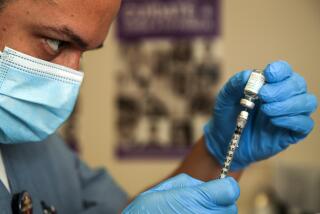AIDS Cases Jump Sharply Among Latinas in County
- Share via
There has been a 340% increase in the number of Latinas afflicted with AIDS in San Diego County during the last two years, health officials report.
Although a relatively low number of Latinas are reported to have the deadly disease, the dramatic increase in a relatively short time poses a warning to health officials, said Binnie Callender, chief of the county’s office of AIDS coordination.
In view of the changing face of the epidemic, which was first discovered among gay white men and is now trickling into other communities, county health authorities are stepping up efforts to reach minority communities, starting up several new programs in August, Callender said Wednesday.
Across the county, 2,587 men and 126 women have acquired immune deficiency syndrome (AIDS), a deadly disease with no known cure. Of the afflicted women, only 29 are Latina. But health officials are concerned because the county is experiencing a jump in numbers that is not being seen by the rest of the nation, Callender said. Nationwide, the numbers of afflicted Latinas has remained fairly constant, representing 23% of the female patient population--up from 20% two years ago. In San Diego, the numbers of Latinas with AIDS has gone up from 16% of the female AIDS population to 23% in two years, Callender said.
Community health workers, however, say that the numbers of Latinos afflicted with AIDS in San Diego is under-reported. Further, they say, the county is experiencing an increase in AIDS among Latina women because the macho-oriented culture makes it difficult for women to insist on safe sex, and more and more women are becoming infected with the virus that causes AIDS.
“Latina women do not have that much freedom to speak up with respect to their own bodies. They don’t have the social power to insist on safe sex,” said Alfredo Velasco, director of the Sherman Heights Community Center.
The problem is made worse because Latinos, like other minority populations, tend not to seek prompt medical care, said Lupe Samaniego, director of health promotion for Logan Heights Family Health Center. And Latina women lag behind their male counterparts in seeking care--a view shared by many health officials, she said.
“The first priority with a Hispanic woman is her family; she tends to wait longer to take care of herself,” Samaniego said. “So the cases you are seeing now are full-blown AIDS. It’s like we are coming across a backlog of cases.”
County, as well as community, health officials say that the services catering to minorities in San Diego have not kept pace with the epidemic, which has stricken more than 179,000 nationwide.
At the Logan Heights facility, which serves predominantly Latinos, more than 60% of the patients either prefer speaking Spanish or speak only Spanish, Samaniego said. “So, if you are looking at clinics or education, you need a bilingual staff. . . . Translation of a pamphlet is not enough, you need people behind it.”
Others, however, said efforts to stem the spread of the AIDS epidemic will be useless unless they also reach into Mexico.
“Since we are on the border, there must be a heavy emphasis on educating the public on both sides. . . . The problem is coming from the other side also,” Velasco said. “You must do both sides, and the county doesn’t have the money or the consciousness.”
Starting Aug. 1, however, the county will beef up its AIDS prevention and treatment campaign, awarding 24 new contracts to organizations for treatment, counseling, and outreach. For the first time ever, several of these programs will target minorities in San Diego, Callender said.
The programs are in response to the steadily growing numbers of cases among minorities. In 1990, for instance, there 89 women were afflicted with AIDS. Of those, 14 were Latina, and today, there are 29, Callender said.
Among the Latina population, health officials have found that about 29% got the disease because they were intravenous drug users; roughly the same number contracted it through heterosexual contact. And 37% contracted the disease through a transfusion; the rest were undetermined.
“Historically, it’s been the gay white male population affected. But now minorities are beginning to be more verbal, more aware of what they are entitled to and more interested in addressing their own needs,” Callender said. “And, the Establishment is responding.”
More to Read
Sign up for Essential California
The most important California stories and recommendations in your inbox every morning.
You may occasionally receive promotional content from the Los Angeles Times.










